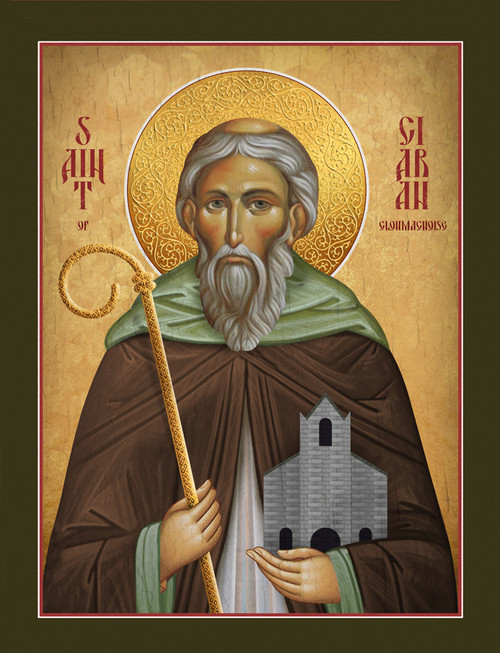Saint Ciaran of Clonmacnoise
Commemorated on September 9
Saint Ciaran (Kieran), who has been described as a lamp shining with the light of knowledge, was born in 512 and raised in Connacht, Ireland. His father was a builder of chariots. He was one of eight children, at least two of whom also embraced the religious life.
Saint Ciaran had a special affinity for animals, and even had a fox for a pet. The future saint left home as a boy, driving a cow before him to pay for his keep. He went to study with Saint Finnian of Clonard (December 12), and became one of the “twelve apostles to Ireland.” Some of the others were Saint Columba of Iona (June 9), Ninnidh (Nennius) of Lough Erne (January 16), and Saint Brendan the Voyager (May 16).
There is a story that one day the students were studying the Gospel of Saint Matthew when Saint Ninnidh came into class without a book. He asked Ciaran to lend him his, which he did. So when Finnian tested the class, Ciaran knew only the first half of the Gospel. The other students laughed and called him “Ciaran half-Matthew.” Saint Finnian silenced them and said, “Not Ciaran half-Matthew, but Ciaran half-Ireland, for he will have half the country and the rest of us will have the other half.”
After spending some time in Clonard, Ciaran visited other monasteries, including that of Saint Enda (March 21) on Aran, where he was ordained to the holy priesthood. He left there because of a vision which Saint Enda interpreted for him. Then he went to Scattery Island to study under Saint Senan (March 8). Later, he went to visit his brothers Luachaill and Odhran, who had a foundation at a place called Isel. Ciaran’s charity was so great that his brothers asked him to leave. They said, “Brother, leave us for we cannot live in the same place with you and feed and keep our brethren for God, because of your unbounded lavishness.”
Saint Ciaran left them and set off with his books in a bag. On the way he met a stag and placed the bag on its back. He followed the animal until he came to Lough Ree opposite Hare Island, where he founded a monastery. Leaving his brother Donnan (January 7) as abbot, he went to dwell in the wilderness.
With nine other companions, Saint Ciaran founded another monastery at Clonmacnoise on the banks of the River Shannon. Within seven months, he became ill and asked to be taken outside and laid on the ground. He looked up at the heavens and said something about the way being steep and difficult. He departed to the Lord at the age of thirty-three.
Clonmacnoise was a thousand years old when it was suppressed by Henry VIII. The monastery was destroyed by Reformation armies in 1552, but the ruins are still very impressive. There is a cathedral, seven other churches, three high crosses, and two stumps of round towers. Fifty kings are said to be buried here with the abbots and monks of the monastery.
Saint Ciaran’s crozier survives to the present day.
Saint Edwin’s body was buried at Whitby, but his head was buried at York in the church he had built. Most of the early English calendars list Saint Edwin as a martyr.
After the death of Saint Edwin, his wife Saint Ethelburga (April 5) returned to Kent, where she became the abbess of a monastery which she founded at Lyminge.







